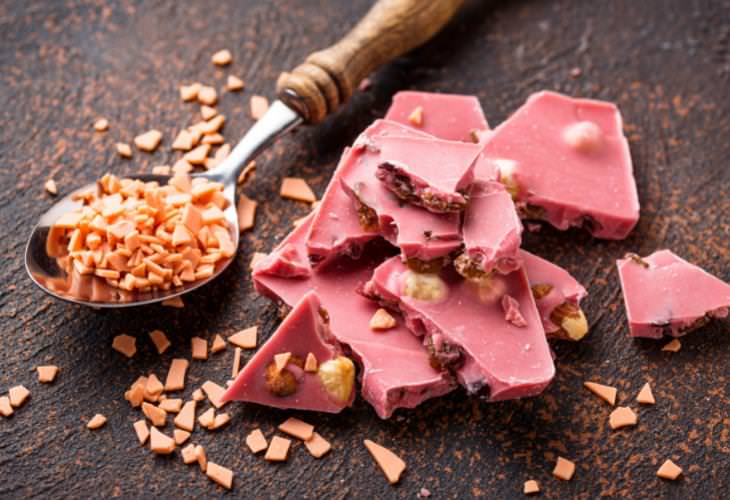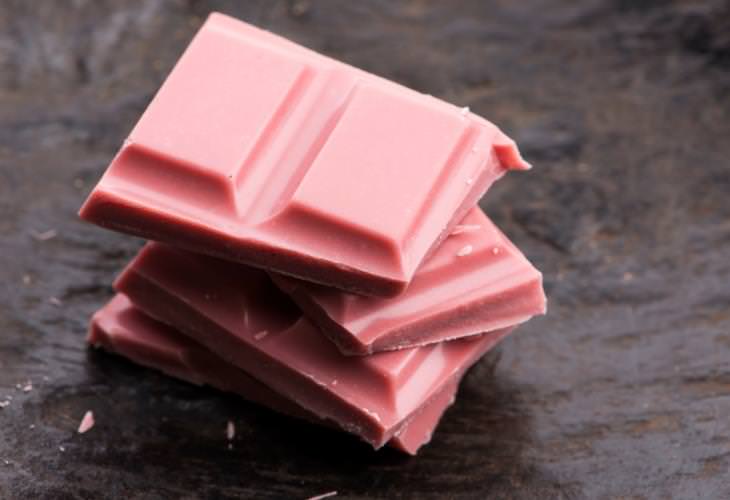Ruby chocolate was created and patented by Barry Callebaut, a Swiss chocolate manufacturer, and introduced in 2017. This is the first new type of chocolate developed in over 80 years after white chocolate made its debut in 1936.
According to the company, they use the "ruby cocoa bean", which is grown in Ecuador, Brazil, and the Ivory Coast, to make this chocolate. While it may sound something unique, ruby beans actually come from the same species of cacao plant that produces the chocolate we are already familiar with. Callebaut representatives have further told the media that the beans that secure ruby status have a particular mix of compounds and that the final product has come after “more than 10 years” of research and development. However, they haven’t revealed exactly what the research was.
Since its introduction, ruby chocolate has been available to consumers in different forms through a variety of brands.
How is Ruby Chocolate Made?
The exact production method of ruby chocolate is still a trade secret. The ingredients of Callebaut’s ruby chocolate are as follows: sugar, cocoa butter, skimmed milk powder, whole milk powder, cocoa mass, emulsifier; soy lecithin, citric acid, natural vanilla flavoring.
The company also adds that its ruby chocolate has no added colors or flavors. In the chocolate's 2009 patent, the chocolate was said to have high levels of pigmented polyphenols. Experts believe that this could be the reason for ruby chocolate’s pink color. The patent notes that the unique processing technique also contributes to the pink color.
Many chocolate experts say that fruitier, unfermented cocoa beans treated with acids are used to create ruby chocolate and to maintain its bright color.
What Does it Taste Like?
So what does ruby chocolate taste like? Imagine you are having white chocolate but with raspberries or strawberries added to it.
Callebaut describes the flavor as "neither bitter, milky, or sweet. It's rather a tension of fresh berry fruitiness and luscious smoothness." People who have tasted the chocolate also add that it has fresh sour notes with a little bit of tanginess to it.
Most milk chocolate is 10 to 30% cocoa while most white chocolate is 20 to 40%. Ruby chocolate is 47.3% cocoa solids, says Callebaut.
Nutritional Benefits of Ruby Chocolate

Since ruby chocolate is said to be made from cocoa beans, it may contain flavanols, a type of phytonutrients. These plant compounds may be helpful to promote good health
A study from 2019 compared ruby chocolate to the dark, white, and milk varieties and found that ruby chocolate does exhibit a different phenolic content than all the other chocolate varieties. The study authors added that this chocolate has a higher content of specific compounds like flavan-3-ols and one more thing...
Proanthocyanidins give the fruit or flowers of many plants their red, blue, or purple colors, and may help prevent cancer, some studies have shown. Flavan-3-ols, meanwhile, have been reported to have antioxidant, anticarcinogen, cardiopreventive, antimicrobial, anti-viral, and neuroprotective agents.
Another study from 2021 found that ruby chocolate contains a wide range of phytochemicals - compounds that are produced by plants. Phytochemicals have been proven to aid the function of the immune system, reduce inflammation, and cells and DNA from damage that may lead to cancer. The study adds: “Ruby chocolate contained higher levels of epicatechin and procyanidin B2, compared to milk chocolate, which may be the result of a shorter or no fermentation of the cocoa beans starting material used for the production of ruby chocolate. Moreover, the ruby chocolate was the only chocolate in which caffeic acid could be quantified.”
This essentially implies that that ruby chocolate is indeed a distinct type of chocolate.
Other than this, researchers haven’t yet confirmed any other distinct benefits of ruby chocolate. However, we should get some updates on this soon.
Related: Dark Chocolate Can Be Beneficial for Heart Health
The Future of Ruby Chocolate
While it was released in 2017, ruby chocolate hasn’t yet become mainstream. That may be because it took a couple of years for it to become widely available to consumers. But a few chocolate experts predict that in the next 20 years, it will be on par if not bigger than white chocolate. This may well happen because chocolate is, after all, one of the most famous treats in the world, and ruby chocolate’s fruitiness may make it stand out among others.
For now, ruby chocolate will remain a novelty item but the future of the fourth chocolate does look promising.
Share this post with friends and family...





